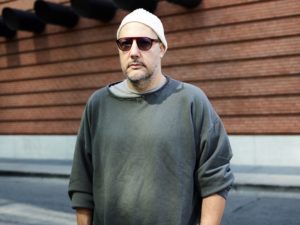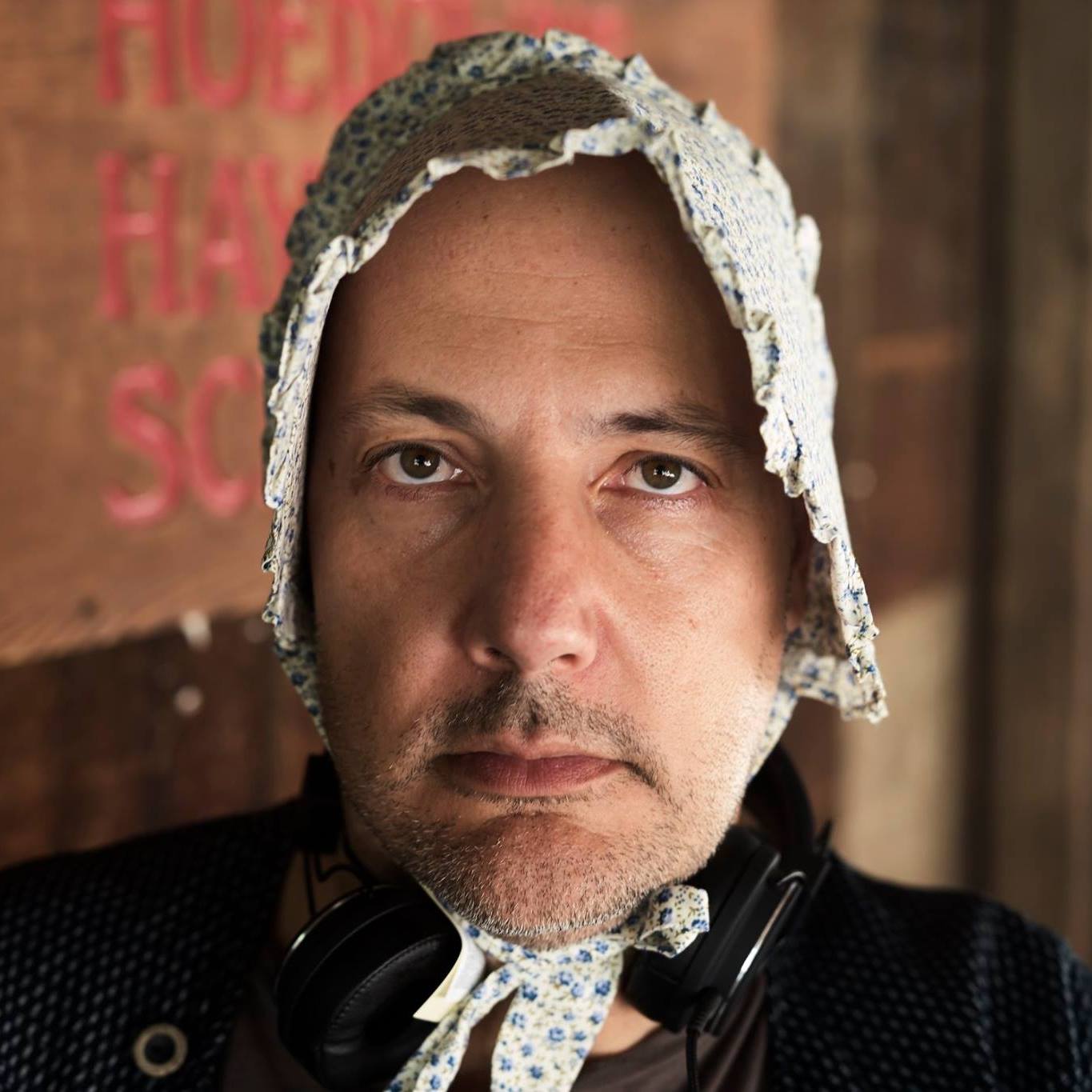Unchain My Art is a program dedicated to artists organized by TheFamily and THE FARM.
We invite artists who understand what it means to be an artist-entrepreneur in the digital age. They’re open to sharing their experiences with you. They don’t come from the tech world, but they hack its tools. Join in!
Check out the first edition with Killason, Nefer, and Frédéric Clad > HERE
Check out the second edition with Holy Faya, (L A) H O R D E and Nodey > HERE
For Unchain My Art #3 we interviewed Stefan Simchowitz.
You can watch the interview or read the video to text below. Enjoy 😉
[1:19 – Frederic Clad] Let’s start with you, Stefan. Who are you, what is your role in the Art Market, your background?
[Stefan Simchowitz] If you want to know more you’ve got to go to my website
www.simcosclub.com.
I’m a hybrid, I’m a collector, a dealer, a consultant, an advisor, a distributor, a financier, a wholesaler, and I function in a way that is very difficult to define in the art world, because I have many different roles, sometimes at the same time. I’m also a photographer, so I take a lot of pictures. I shoot for Italian Vogue; I document everyday of my life and I share it on my social media, on Facebook. There is a very big narrative to my art dealing practice. I’m very transparent, you really get an overview about my life, my people, my family, my people, who I’m connected to socially. So, it’s very transparent – and by transparent I don’t mean I only show what I wanna show – I’m very transparent about my life, and this is very unusual for an art dealer as the gallery is focused on promoting artists. Very few people have an idea about the identity of the gallery, of who is behind the scene, it’s a very small group of people who have a relationship with the dealer, who the dealer is, the political opinions of the dealer.
Maybe this came because of your background in the film industry, you started as a producer?
[Stefan Simchowitz] I don’t think we need to find a reason why I’m like I am, like, why is a hedgehog a hedgehog? It’s just a hedgehog. I think that people in the film industry are equally hidden. I think the people in the film industry are very hidden. You’ll find very few successful producers messaging publicly on Facebook or anything. They try to maintain a level of privacy. My reason behind it is I think you can provide a certain real social context behind what you do and how you do it. I think a lot of people don’t message because they want to cultivate neutrality, there is this notion that neutrality is good for business, which certainly is. And I admonish this. I think that we should have positions, and that people can navigate using those positions. We live in a world where the liberal establishment has said that you shouldn’t have a position, that a position is very negative. I take the opposite stand.
[5:08 – Frederic Clad] So you are radical?
[Stefan Simchowitz] I’m not radical. I’m a white Jew from South Africa from an affluent family who went to a private boarding school in England when I was 7. I wouldn’t say I’m radical.
But it seems like that from the outside, when people call you the Satan of the art world or the Donald Trump of the art world!
[Stefan Simchowitz] Well I don’t drink, I don’t take drugs, I try to walk 20,000 steps a day. I’m very practical, very risk-adverse. I think people’s description of radical is anything that is outside of their understanding and comprehension, out of their aesthetic range. They don’t have an experience of it, therefore it’s radical. These terms are really misused.
I just speak my mind: if that is radical in the 21st century, well God bless the 21st century!
[6:50 – Frederic Clad] Good, let’s move on. The idea of Unchain my art is that artist are entrepreneurs and that entrepreneurs are artists. They both do things that don’t scale. We took this idea by Paul Graham who also wrote Hackers and Painters. What is your opinion about this comparison?

Photo from Stefan Simchowitz public Facebook Profile © Stefan Simchowitz
[Stefan Simchowitz] I think it’s interesting, I have never encountered a venture capital firm that gives artists digital media skills and training them to be entrepreneurs. I do think that one of the failures of art schools, for both artists and curators, is that there is a lack of practical training. And I think it’s from a curriculum point of view, one of the great evils of the art world are the arts schools. It’s the entity that extracts capital from artists, at scale, in a way that is completely problematic. If there is anyone in the industry able to make real money from people’s desire to be an artist, you know, at real scale, 40,000$ a year, 100,000 students per year, it’s the art schools. These guys are more able to extract money from artists with no chances of succeeding than anybody in the world. These guys who preach the mythology of the artist, the ethics of an art practice, the unfairness of the system that isn’t accepting you. They teach you, take your money and then fetishize the failure you are probably undergoing as a failure of the system of capitalism and its inherent problems, as it’s not valorizing your creative output. So they extract your capital, and then you leave, and have failed, after spending all this money at art school. It’s a very ironic system, a capitalistic system that teaches you Marxism and leaves you with a left-leaning thinking that when you fail you have an excuse for it.
I do think that, very simply, artists should understand the basic laws of supply and demand, they should understand the basics of what every producer of goods and services in the world has to understand in order to be successful and what every distributor or retailer needs to understand to be successful, and they don’t. And worse than that, they sort of have this ideological mythologies of right and wrong, left and right, that really alienate them from these systems, and for the most part make it very difficult to deal practically with their creative output or their endeavors.
This is also true on the curatorial side. I have a friend, Cesar Garcia, who runs an institution called “The Mistake Room”. He is this amazingly impressive guy in his early 30s and he comes from absolutely no means or capital whatsoever, he started this non-profit foundation, amazing! And he was telling me one day that when he was doing his curatorial studies they never told him “one day you might be running a foundation”, how to wear a tie, he never wore a tie, how to use Excel to make a budget. So, they taught him all those curatorial skills but none of the skills to run an organization. I really do think that the art schools’ itineraries are highly problematic for the long-range success of their student bodies. It’s a fundamental pillar of the industry that needs to be changed, challenged and upgraded.

Photo from Stefan Simchowitz public Facebook Profile © Stefan Simchowitz
[11:30 – Frederic Clad] This is what you call morality in the arts? You often say that we have to stop with it, ideas like museums are better than private collectors, etc.
[Stefan Simchowitz] I often try to think about how I can boil my theories down in a single idea that is scalable, what is the message behind the noise of “he did this or she did that”. The morality issue is at the very core of our socio-political and economic system as the cause of so many ills of the system. What societies have done, and what systems of consumption have done, they have manipulated people’s morality and their idea of morality to extract resources from them at scale.
I’m gonna jump outside of the art business because I think it’s a more adequate example: the healthcare industry. 75% of all expenditures on healthcare are spent in the last 6 month of people’s lives. So, we have an underfunded healthcare system across the globe and the reason is to keep people living longer. You can be kept alive. They’re giving hip surgery to 90-year-olds and bypasses to people who are 94, keeping people alive with septic shock when they’re 96. It comes down to this moral issue of doctors who must preserve life, this lack of moral acceptance of the passage of time.
Or we can go to the prison system in America, where we’re tough on crime; and there we have criminalized every non-violent crime and put people in prison for $40,000 a year, which creates revenue. It’s all to create a morality that is completely incoherent, that increases consumption and growth, because the economic system is essentially defined on 2 metrics: growth and full employment. In the post-war period, there is a fixation on governments to have full employment and constant growth. So, you have healthcare growth, which is not necessarily good, you can have a fast-food industry that gives people diabetes, and that’s growth on the fast-food side and the healthcare side, but it’s not good growth. So in order to break out of that, as a species we have to identify on a moral basis what is good and bad, right or wrong.
The art industry is a very interesting place because it’s the crucible of the elites and of intellectual morality, it’s the place where the elite play. It’s hypersensitized to a lot of structures. It deals with the artist producer as a mythical figure, he loves his art, and everything is done because he is pure, he doesn’t like money. It’s all about the art. This is a myth. Picasso had a Rolls Royce in the 1920s. He loved it!

Photo from Stefan Simchowitz public Facebook Profile © Stefan Simchowitz
Mark Grotjahn, one of my favorite artists, drives around L.A. in a Bentley with a driver. There’s this myth that artists are not capitalists. They don’t want money. Many of them who failed are like: “I don’t like money”. And this myth needs to be broken down. Artists like money, they are often greedy like everyone else. There are these myths that are false, and you start to deal with artists in a very specific way, you deal with them in this mythical sense. Artists essentially feel obliged to fulfill that role, as they should. So, everyone ends up playing with each other in inauthentic terms, they end up playing with the reflection of what they are supposed to be. We have got the collector: the collector must be a connoisseur (a middle-class person with money who has acquired with through the action of knowledge, taste: they can see a good wine from a bad wine, a good painting from a bad painting). And very few people actually have knowledge or have the natural instinct for taste; because taste is a talent, like speed in an athlete, only given to a few, it’s not something you acquire. Some people just have that thing. So, the art business has created this concept of connoisseurship, which elevates the “middle-class bourgeois” into the elite state of intellectual authority and good taste. And many of these connoisseurs have terrible taste. Again, it’s a moral issue of elevation and status acquisition. And then, the gallerist of course is someone who cares only for his artist and doesn’t show his ideas and doesn’t communicate, he lets the artist communicate. This is the myth of the gallerist, the myth of the curator, the myth of the writer who writes for ArtForum or other magazines, who is pure… But people can be bought in different ways. Status is a currency or belonging to a group is a currency… So artists go to art schools to get critiqued by some usually failed artist who explains how to make art. And these mythologies have extracted resources and capital from the creative community at massive scale. And they’ve also created, ironically, a monoculture of distribution and cultural production by creating these self-reinforcing modes of production and consumption. For example, in 2017, when you meet a young banker in their early 30s, they talk about buying an Andy Warhol, not a local artist they have seen in their community, to get this social status: “Oh you’ve got knowledge, this is connoisseurship”. It’s not like in the 1960’s where you would buy Andy Warhol who very few people had heard of, as an unknown artist. We’ve taken a lot of good out of the system.
We have a globalized world with globalized production and amazing resources, I think artists today are producing better quality work than they ever produced in the history of mankind, they have got better resources, they have got access to the internet, to historical data, information … They have got access to better materials, than the world has ever had for production and output. I strangely think that we live in a golden age of art production. But yet we’ve got a problem in that the distribution channels, the production channels have been marginalized, alienated by this sort of essentially moral myth of what kind of role you’re supposed to have. Some of the most interesting artists who I find, I had tea yesterday with an artist named Molly Soda. She is a wonderful artist we are gonna work with her. I’ve been following her for two years. Molly has never heard of most of the well-known artists that you know today. She has never heard of many of the names who are collected by most collectors. Do you know this person? No! Do you know this person? No! She just has built her community online. She doesn’t know all the galleries in London. She does not have any idea of who these people are. And yet, she’s known by hundreds of thousands of people and she’s on the list of many people. So, she’s done a very good job of on her own, building her identity, her aura outside of the network, outside of the mythology of the art business. She did that very successfully.

Photo from Stefan Simchowitz public Facebook Profile © Stefan Simchowitz
[21:50 – Frederic Clad] So, Molly Soda is a very interesting example. She is a post-internet artist and you are very close to artists like Petra Cortright, Mark Horowitz, Artie Vierkant…
[Stefan Simchowitz] One of the principal attributes of post-internet is that it doesn’t have a geographical centrality. One of my mantras is that the periphery is the new center of the networked environment. So, as you create a network, then the periphery is as important as the center. This is one of the fundamental changes in the art industry. Periphery is, like Molly Soda, being networked into the center, without being central to the conversation as opposed to the ones who were built in the post-war period. Post-internet is the simplest way to explain it.
When the Internet began, there weren’t centralized places like Facebook or Google, there weren’t monopolies of groups of people, it was a place of discovery. You would go to a website, you would write down the URL, it was like being in a forest, that was unclear. As people got onto to net, they would find new trees, or build new trees. The post-internet artists grew up in this environment, in this age of discovery. As the Internet consolidated into these monolithic entities (Amazon, Facebook, Google, Snapchat… we don’t know what they are but we all love them), that pre-Internet environment got decimated, the forest got cleared literally, like the Amazon jungle got cut down. Each of us now is a part of the forest. So, we are currently in a post-Internet environment. This is my definition of what post-internet is. It’s this environment after the internet was discovered. It’s almost like a post-apocalyptic environment.
Dystopian or Utopic?
[Stefan Simchowitz] It has elements of both. For example Petra Cortright doesn’t even have a bachelor’s of arts, which is very unusual. I had an artist, and most gallerists refused to put him in a show because he did not have an MFA. And he quipped to the gallerist that he had something better, Stefan Simchowitz. They put him in the show, and the only thing that sold in the show was his work, ironically. His work was better than anything else in the show.
I just do my job and find great artists. I’m not constructing some mythological, satanic narrative…that’s all bullshit! I just try to find good artists that people like and wanna hang on their walls. It’s pretty simple. I’m not trying to find art that a curator has to write a 10-page essay on and the museum has to show so that the bourgeois connoisseur can say “Oh, look I bought this piece of dog crap we can put in the corner of our toilets, that I don’t understand”. I like stuff you can put on walls and then you look at it and say “Wow, this is cool”. Art has a decorative component that is very important. The wealthy don’t buy art because museums have it, they buy it to decorate their homes. The Mark Rothko function has a decorative function.
The post-internet artists do two things: they experience art history through the net (instead of walking through the Met, the museums, going to art history classes or going to art schools), their consumption of art history happens online. It’s a very different consumption, because it’s not as linear. They Google a tree and they get a picture of a tree done by Goya, a picture of Hyde Park, a picture of an animé tree … It’s very different to the pre-internet artist who went through the academies and got canonized.
Donald Judd is gone, you got to deal with his legacy, what it is to be a painter in the shadow of abstract expressionism, how do you deal with minimalism, and pop and the legacy of Andy Warhol. Somehow these artists have escaped that tractor beam of post-war art history, because they were not connected. They want to expand the field. It’s open to an whole new narrative for art production. The post-war period is monolithic, it’s a monoculture of collecting. You’re a connoisseur if you understand the canon. And it’s been a really great construct. And certainly, these are great artists, this period is very important. This post-war canon, from the 1950s to the early 2000s, what it’s done is to create a kind of closed system. It’s a very convenient system, because you have a certain amount of artists, you have a collecting base that can be elevated by understanding the canon, prices can be raised, and you can build a real market, auction houses can sell them to reach the finite level of production. And people who market this canon never say there is great art being produced out there, what they say is that they are collectors focusing on a certain type of art, “I’m a serious collector, I’m a graduate collector of the canon”. So ironically, this methodology kills the competition: « Everything else is shit, in the 1960s they made better art than today ». And the market can raise the prices, can elevate this corporate structure. What is very interesting to me is how do you change that system; how do you get people to engage in culture outside of this canonical constraint which is extremely elitist, profoundly available for just a handful of people to collect this canon. There are a few tactics and techniques that are being used to promote this. There is this mythology that good art is not decorative. For example, Josef Albers, you would say he is not decorative. He is a decorative artist. He is a great artist and he’s a conceptual artist. There is no artist whose capability to decorate is greater than Joseph Alberts. They want the connoisseurs to say they collect Joseph Alberts not for decoration, but because they’re sophisticated and they understand. The main reason why people buy this stuff is because Michelle Obama in the White House had it decorated by Michael Smith. He put Joseph Albers in the Obama White House because it fits. When we start to get rid of the mythology of why people do things, we can start to have a real dialog with them and escape these monocultures of distribution, which is interesting to me: how to get people outside of the box.
[33:35 – Frederic Clad] Do you think we are living in a new Renaissance, like Florence of the 15th century?
[Stefan Simchowitz] I think people like to make comparisons to say that things are like the past, because it makes us feel safe, because then the future is predictable. We have no f*** idea what’s going on. Much as I’d like to say we are in the new Renaissance, we have no fucking idea what’s going on! The world is scaling at speed, and because we have no idea what’s going on, we have to have a set of skills that we build, a set of skills to be responsive to not knowing what is going on. If you think that you’re in a new Renaissance, you’re going to react in ways that are you think they would have done back then, and you’re going to come with the wrong set of solutions to respond to what’s going on now, because you’re going to try and predict what’s happening now and in the future based on what happened in the past. And I think it’s something that Mankind seems to do on a consistent basis. The future and the present, it’s not like the Renaissance of the past. It’s different. There are attributes: it’s the same people, the same greed, but it’s a very different moment. The Renaissance… I don’t think so, actually. If I think about the Medicis, the Papacies, they were willing to investing at scale in culture, these guys were the tech elites in California today. But now there is a profound indifference to culture and art in Northern California amongst the tech elite; It’s profound, it’s consistent. I would almost say there is a scaled indifference to culture and art. So, there is a very different relation to art than for the Medicis, the papacy, who could invest in changing the cities through art. These people couldn’t care less about art, they care about scale, scalability instead of culture. This is one of the fundamental problems in the technocracy; there is no respect or understanding of culture, philosophy and ideas. In this environment, we have some profound challenges to this, and I think those challenges have to be overcome by getting rid of these mythologies that alienate the technocracy from the collecting of art. Because they don’t buy into those mythologies, they have a different set of mythologies. So, when we get rid of the myth, we can then start to have more practical conversations: how to get capital engaged in art in a different way.
We are in a profoundly complex place. I said it in a talk last week. I am at war; not against the right or the left, or against an ideology. I’m at war to preserve culture in its raw state. It’s very difficult. The art world has sort of said we will preserve this kind of culture. For example, I always say to people, if you are an artist and you publicly say you voted for Donald Trump, you will never be invited in any show across the country, no matter how good an artist you are. This is a problem.

[38:27 – Frederic Clad] You said you are at war, so who is your enemy? The Art World?
[Stefan Simchowitz] No, the preservation of culture. The expansion and preservation of culture. It’s not a war against people. It’s a war for something, a little bit like the war for environment.
I don’t think people or corporations actively want to put culture down. It’s not like the Soviet Union.
The technocracy in a strange way does not want to invest in culture because they don’t want to be seen as collecting art for its wealth component. There is a big fear, they don’t want to be accused of “wealth porn”.
You know, I walked in my local bank recently and the decoration is really terrible. I said to the banker « Could I lend you a piece of art for your office? » He answered, “I would love that but the bank wouldn’t let me hang a photograph of my family on the wall”. So what the corporate state has done to culture is it effectively declared war on culture by commoditizing everything. So the corporate capitalist state has essentially removed culture completely from its environment unless they’re marketing culture and creativity in their ads to show they care about your business. We live in a strangely authoritarian regime that targets culture to create uniformity to scale. Culture sits on top of this pyramid of abstract output, and you have to challenge the ideology of the socio-political economic environment.
I did this very interesting thing with this corporation called ICM Partners, which is a talent agency in Los Angeles when they called me for some advice about art. They were probably gonna put some prints on the walls, like many corporations. I told them, « Let me loan you 400 artworks for your office, I’ll curate them and hang it like a museum. » And they went for it. It has literally transformed their brand. People go there every day, they experience contemporary art in a way they had never done before. I think the art world has to really view this requirement to preserve culture in a much more engaged and open platform that isn’t restricted to the gallery, the art fair, the museum, the canon, the system; they really need to open up. I think that what you are doing, teaching artists more practical skills, how to communicate through digital media, these are the things that are going to preserve culture and enable it to escape these monolithic kind of structures. Expand the field! To counterbalance this negativity, we have the network that can be used to distribute culture. But in order to do so, artists need to understand the mechanisms of those constructs (capital, economic, competitive) and they do need to learn a whole different set of skills in order to compete in this environment. Big galleries and distributors don’t sell inexpensive art because they make more money selling more expensive art. So they say “Collect real art that is expensive, the inexpensive stuff isn’t real, it’s not as good as the expensive”. They conflate quality with price very easily because it’s very convenient. I don’t believe in that. I believe fundamentally you can build amazing collections with very little money and capital. But the connoisseurs, they have no taste and their knowledge is usually quite narrow but the art system wants to tell them they don’t have narrow knowledge, because they can understand the canon, they’re very knowledgeable.
[45:28 – Frederic Clad] Now, let’s talk about business models. Your communication is authentic, different from the standards of the art world but you don’t talk a lot about your business model. Concretely what are your revenue streams, your added value?
[Stefan Simchowitz] I don’t consider myself as anything. Everyone wants to know my secret sauce, what is the formula. I view myself as a service provider to clients and collectors to access art. From an emerging contemporary business, I’m a wholesaler, financier and distributor. I wouldn’t even say that I’m a venture capitalist.
In every business from the banking to clothing, there is a producer of goods and services, the artist that generates cultural products. And there are wholesalers, financiers and distributors who manage distribution of these goods and services to retail chains, to the retailer front line. Those wholesalers are very powerful because they help with supply, pricing and they finance the factories by giving the factories an idea of what kind of retail revenue can be had on the frontline. This position is very important in the chip industry, for example.
The art world has scaled in the post war period; it has gone from a handful of collectors and producers of art to thousands. And from a business perspective I believe that the only thing that’s going to save emerging contemporary art from collapsing into a sort of a mess, is a new supply chain. I want to create a supply chain for emerging contemporary art with the artist as a producer of art who, instead of interacting directly with a gallery system, can interact with a wholesaler who can aggregate the demand from different retailers and manage that. Because generally what happens with young artists is that they have multiple galleries, because it’s very risky to show their work, it’s a very fragmented business. Those galleries don’t communicate with each other; they are small operators, often unprofessional with small infrastructures. And they do it for different reasons. One does it because he likes it, another does it because he’s bored… It’s a very uncoordinated business system in comparison to big galleries. What I try to do is to create an infrastructure that guarantees stable revenues for the artist in order to sustain production over a longer period of time. The studio is the factory and a well-financed factory produces better products in any industry. A factory that has stable working capital is going to make a better product: Clever capital. I think the art business, galleries, artists, they don’t even know what working capital is. They don’t even understand that every successful business turns over their working capital 3 times a year. The only way to compete with the big galleries is to create a different system; the current system of fragmented distribution has completely failed. The mythology behind it that the artist should be free, and the gallery should do what they love, is really hurting many emerging contemporary artists whose work is very good.
In my system, I say to my artists “Look, we don’t need to sell anything for two years”. Artists have to focus; the product is everything for me. If the product is good, it speaks for itself. All I care about is getting a well-working factory for the artist. The distribution is secondary to that.
So, this is the definition of “Do Things that don’t scale”?
[Stefan Simchowitz] Yes. But you know everyone is asking to me, how are you going to scale your business? It’s not possible. One of the fundamental flaws in our global consumption environment is this notion that scalability trumps everything. The slow food movement we have, the artisanal movement and important and growing, and we need a “farm-to-table model” for the arts. I’m not interested in having a hundred artists, I’m not interested in flying in a private plane, I have a very good business; I think you can be very successful but you don’t need to generate 10 billion dollars in revenue, you don’t need to scale. If many more people had this artisanal approach, this more precise approach, it’s gonna be much better. The problem with people like you who have venture capital money in front of you, is you think about scalability, and in the end, you’re gonna take advantage of artists, because you cannot scale. Talent is a rare thing to find, a rare thing to develop and time consuming.
So where it does scale is if you are able to manage successful artists, the amount of capital those artists can generate is huge. For example, Mark Grotjahn probably sold $75 million of art last year. The numbers are enormous. So in a sense there is scalability in the amount of money you could make but you can’t think about that. Once your product is great you can make a fortune, but it doesn’t scale numerically. It’s a sort of artisanal opportunity that, over time, scales individually.
[56:15 – Frederic Clad] Maybe what you scale it’s your network. We can make this comparison with Leo Castelli’s friendly galleries or Paul Durand Ruel’s magazine dedicated to art to educate young collectors. They all expand the field.
[Stefan Simchowitz] I think so; I think expansion of the field is key. Whether it scales, I don’t know. I don’t think it scales like Facebook scales. At the end of the day we are talking about the 1%. I would love to say it democratized art. What is interesting to me is scaling within the category of the elite.
[1:02:00 – Frederic Clad] Is it possible to disrupt the art market? We see that all industries are being disrupted. Even the industries with the highest barriers, like education and healthcare, are being disrupted. Is the art market the last industry to be disrupted? Is it what you are doing?
[Stefan Simchowitz] Yes, I’m disrupting it.
You know I got an ad from Artsy the other day, it was: “We can help you analyze your investments in art. Before you buy a piece of art pay us an $800 consultancy fee”. And I was thinking, I was kind of amused, “This is the company disrupting the art business by sending mass email, helping you to invest in art”. They are not disrupting it at all. They are doing the opposite. When you register on Artsy and email a gallery about an artist, a pop-up window appears and says, “Are you a collector? Have you bought from auction before? What is in your collection?” They are proliferating this kind of mythology, they do the exact thing as the gallery, and they just put it online. They are not disrupting it, they are reinforcing the system. They reinforce all these myths at scale.
Disruption of the art industry is not gonna happen by building a consolidated website that basically changes the business. It’s gonna happen the same way that a virus creates a mutation in a species and the species evolves based on that mutation. Culture is a part of the evolution of the species, I think. So I think it’s open for a disruption but not in the classical way as you as a venture capitalist imagine it. It’s gonna happen as a set of ideas and principles that travel through the network and get picked up by people and then evolve that way.
If your look at history: it’s not companies that change history, it’s ideas (Galilea, Hubble). So I think the Art business will get disrupted by breaking down the mythologies, the morality that have kept the art industry in its stasis in the last 50 years. I think it gets disrupted by no one person but a lot of people. It’s gonna be a shared and nonlinear form of disruption and it is on the way, it’s absolutely happening. It’s just not something that can be consolidated and owned.
I believe that the greatest conceptual artists living today are theoretical physicists and theoretical mathematicians. They are thinking in terms of culture, using every single capability that man has in its ability to think and hypothesize. I think about culture more broadly, my definition of cultural production, artistic production, is probably far broader, wider, than a traditional gallerist of museum director, its scope wider. I think there is a lot of artistic production that is made that isn’t defined as artistic production by the industry, but is completely artistic at the core. I just read the Wright Brothers’ biography, they weren’t inventors, they were artists, if you read their book they’ve lived like artists, they thought like artists, and they were obsessive like artists. They were absolute creators. So, I think you’ve got to increase your definition in terms of what you call art and then you can have a different conversation.
[1:08:21 – Frederic Clad] The last question for Unchain my Art #3: What would be your 3 pieces of advice to an artist today?
Make yourself as easily reachable and visible as possible.
Have a Facebook Profile, an Instagram Profile.
Have your phone number and website on that profile.
Answer to your phone whenever it rings and check your emails consistently.
Make yourself totally and easily accessible. So that when someone calls, whoever it is, you are there. Communicate who you are, don’t put pictures of cool things you saw online.
Create your identity so that we see your face, your family, contextualize your studio; so that someone who looks at your social media can understand who you are, what your story is, what your production is. Make it really easy to read. Because there are so many profiles you go to and you have no idea who you’re dealing with.
Make it simple, we are stupid out there most of us, including myself.




